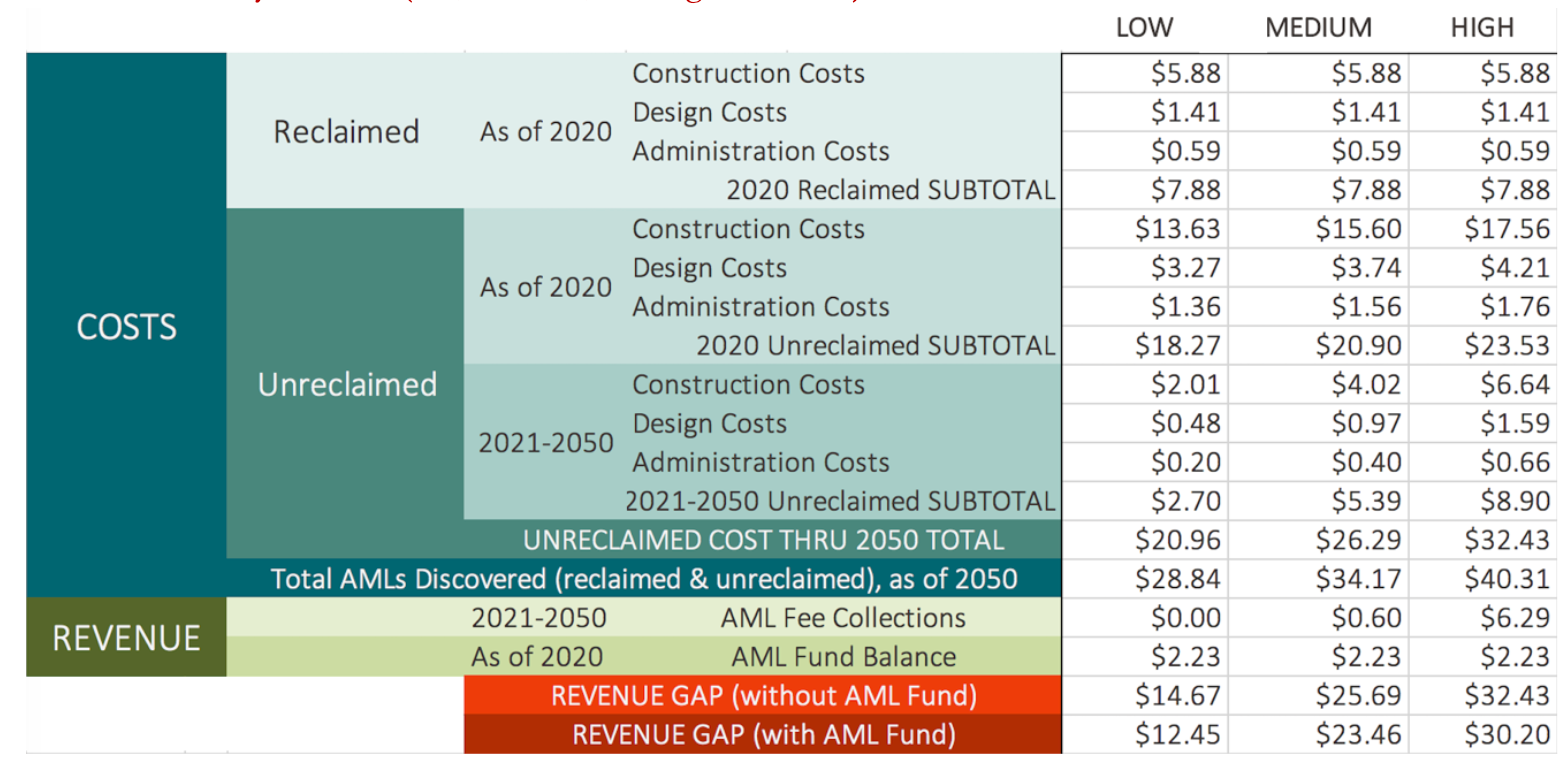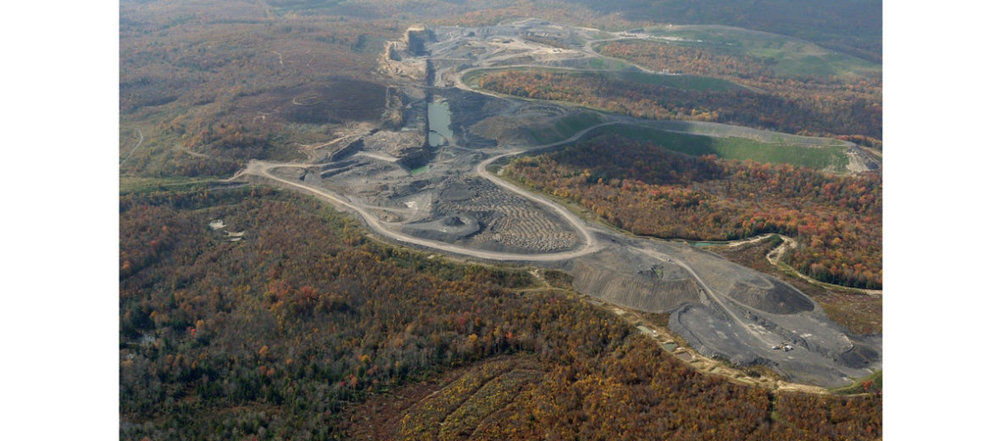This afternoon, Congress will hold a hearing on a slew of bills that seek to clean up land and water damaged by the coal industry before it was regulated in 1977. The hearing rightly highlights the urgency of reauthorizing fees on coal production that fund cleanup, which are set to expire in September even though the job of reclaiming coal-damaged lands is far from complete. In fact, the extent of remaining damage is likely much larger than previously understood: two or three times larger than the official $11.4 billion estimate.
This “official” estimate comes from the inventory of Abandoned Mine Lands (AMLs) managed by the federal government. But it is commonly understood among AML officials that the real cost is significantly higher. Why? Three main reasons:
- The inventory is decades old and many estimates are not updated for inflation.
- The inventory includes only construction costs, not engineering design or administration costs.
- The inventory does not include all of the remaining AMLs in the field.
In a forthcoming ORVI report, I develop cost estimates that adjust for these deficiencies and provide what I believe are more reasonable estimates for the cleanup costs of unreclaimed AML damage in the 25 states and 3 tribes where they remain: between $21.0 and $32.4 billion by 2050 (low and high scenarios). Table 1 includes my low, medium, and high scenario estimates. I walk through the difference between these estimates and the official figure in the post below. The details of my calculations and assumptions can be found in the Technical Note (Working Paper).
Table 1. Summary of Costs (low, medium, and high scenarios)

How much are unreclaimed AML construction costs?
The official inventory says $11.4 billion, but a more reasonable estimate is $15.6 billion (medium scenario), which is calculated by multiplying the extent of remaining damage (feet, acres, etc.) by average costs of reclamation for some types of AMLs, and uses cost estimates from the inventory for other types of AMLs—but adjusts them for inflation.
The first step is to establish construction costs, which serve as a base for the other costs. In order to develop more reasonable construction costs, I use recent average construction costs for each AML Problem Type (PT) estimated by IMCC/NAAMLP (2019) and multiply these average costs by the number of unreclaimed units in the inventory. The trick is that average construction costs for some PTs aren’t available. For these, I use the cost estimates from the inventory but updated them for inflation. But doing so requires knowing how old a cost estimate is. We can’t be certain when exactly a cost estimate in the inventory was last updated, so I use the oldest and newest possible dates for each AML to establish high and low scenarios and then average them to estimate a medium scenario.
How much are unreclaimed AML costs if you include design and administration costs?
Design and administration costs are $5.3 billion, so total unreclaimed costs are $20.9 billion (medium) as of 2020.
The costs for reclamation in the inventory only reflect the costs paid to construction contractors. But reclaiming damage from AMLs also requires engineering design and government administration costs. According to OSMRE’s Financial Business Management System (FBMS) data, over the history of the AML program, for every dollar spent on construction, an additional $0.24 was spent on design costs and $0.10 was spent on administration costs. I apply these assumed design and administration costs to each dollar of construction costs in my estimates.
How many AMLs will be “discovered” between 2021 and 2050?
I project $5.39 billion in total reclamation costs will be added to the inventory in the next 30 years (medium scenario). So, by 2050, there will be $26.29 in total unreclaimed AML costs (medium scenario).
Over the history of the AML program, the universe of known AML problems has grown, for three main reasons: 1) known AML features degrade over time, requiring expanded or re-reclamation, 2) previously unknown AML features are discovered and added to the inventory, and 3) mine pools and Acid Mine Drainage (AMD) remediation require ongoing reclamation. As we look ahead to the next 30 years, I estimate that between $2.7 and $8.9 billion of unreclaimed AML costs will be added to the inventory. These estimates are rooted in the annual rate AMLs were added to the inventory in past decades, and low-high scenarios assume that this historic rate of discovery declines more or less quickly.
How much AML have we reclaimed already?
We have reclaimed $7.9 billion in AML damage – only 27% of the $28.8 billion of AMLs we’ve discovered as of 2020. That represents an even smaller 23% of the $34.17 billion worth of all AMLs projected to be discovered by 2050 (medium scenario). In sum: we’ve only reclaimed about a quarter of all AMLs over the 40-plus year history of the federal AML program.
How many AML fees will be collected between 2021 and 2050?
$0 if AML fees are allowed to expire, and between $0.6 billion and $6.3 billion if they’re reauthorized (medium and high scenarios).
If current AML fees are collected through 2035 (and on metallurgical coal through 2050), then $0.60 billion in fees will be collected (medium scenario), using coal production projections from EIA2020 in its lowest production case (the case projects coal production under a $35 CO2 fee). Collections could be $6.3 billion in the event that AML fee levels are doubled and coal production continues through 2050, according to the EIA2020 reference case (high scenario).
In summary, this is how I got to the $26.29 estimate (medium scenario): The inventory says there are $11.4 billion in unreclaimed construction costs, but my estimate (using a method based on more recent average cost estimates and adjusting for inflation) is $15.6 billion. Add $5.3 billion in design and administration costs to get $20.9 billion. And then add $5.39 billion in AMLs that’ll be discovered in the next 30 years to get $26.29.
Actual reclamation costs may end up being even higher—even my high scenario estimates do not include what may be required to treat long-term AMD, and we very well may end up discovering more AML damage than my projections suggest. But they show that the cost will, at least, be much larger than the official figure.
It’s also worth noting that these estimates are only for cleanup costs. AML damage has many costs not captured here: the cost of lives lost to dangerous AMLs, negative health impacts, the social cost of methane emissions from AMLs, the cost of local development deterred by AML pollution, the cost of damaged or destroyed local ecosystems, and on and on.
The longer that Congress allows thousands of acres of AML-damaged land and water to linger, the more these sites will cause direct and indirect casualties among coalfield communities, downstream residents, and across the planet. The need to repair mine-scarred damage is larger than previously understood, but it’s not just about more cleanup funding. In a future post, I’ll dive into a broader assessment of the program.

